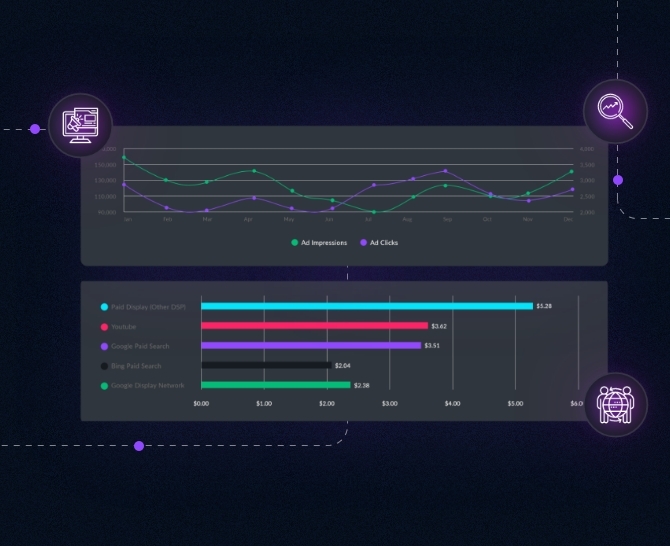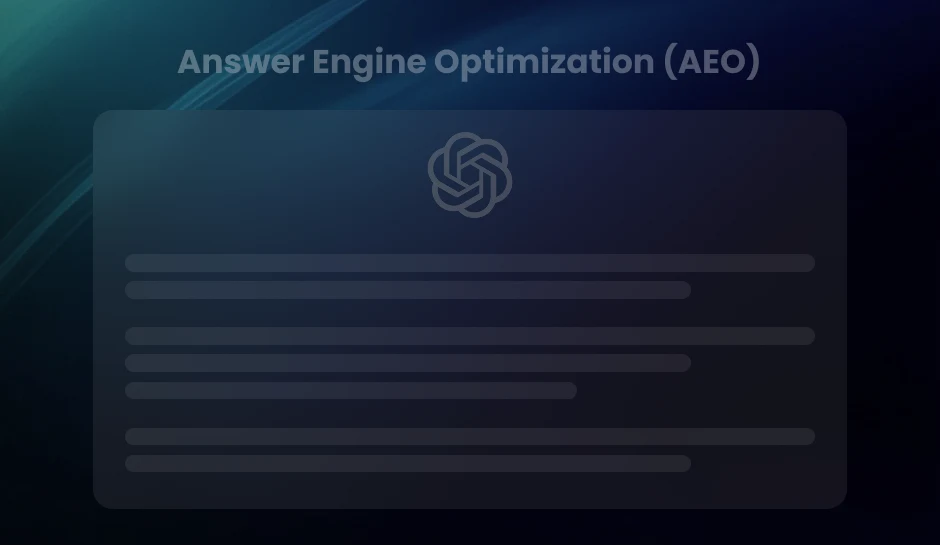
6 B2B Marketing Trends for 2025
As marketers start preparing for 2023, there are many upcoming trends that they need to stay updated with. Here are 6 B2B marketing trends for 2023 that might help B2B marketers with their marketing plans.
Introduction
B2B marketing isn’t the dry and static routine it is made out to be–it is a dynamic force affected by ever-changing trends. Some of these trends run deeper than the ones that affect B2C marketing because B2B marketing doesn’t concern itself with as many vanity metrics and beautifying tactics.
With 2023 around the corner, here is what a B2B marketer can expect in the coming year:
Top 6 B2B Marketing Trends
- Analytics is Changing
- Videos Will Remain Relevant
- Interactive Content Consumption Will Increase
- The Popularity of Podcasts Will Skyrocket
- The Resurrection of Email Marketing
- Alternative Tracking/Farewell Cookies
Out with the old, in with the new. Google announced that it’s retiring Universal Analytics on July 1, 2023. Universal Analytics, also known as “UA” or “Google Analytics,” is what many B2B marketers use to measure engagement. It’s being replaced by GA4. This change is happening as third-party cookies are being retired and the metrics for data analysis are changing, requiring new tools. GA4 uses event-based data instead of session-based data and includes privacy controls such as cookieless measurement, and behavioral and conversion modeling. The property doesn’t only replace the soon-to-be obsolete Universal Analytics but goes leagues ahead to improve consumer experience in a cookieless future, still allowing marketers to continue to gain valuable insights.
As the primary and most engaging form of data consumption, videos will remain relevant for they make the viewer focus multiple senses on your content. Video marketing is made more engaging with good storytelling, the kind B2C marketing relies on, except without the distraction and with straightforward messaging that focuses on the product and the problem it solves. B2B videos, unlike B2C videos needn’t oversimplify the message, but they should still steer clear of overcomplications and jargon. Making your videos attractive and visually appealing will not make your brand seem frivolous. In fact, they may stand out from the crowd of dull and dreary B2B content.
Virtual Reality is the only format that can be even more engaging than a video. With AR/VR consumption increasing, marketers are turning to the Metaverse to showcase and sell their wares. As more people want to engage with content, there is a greater need for such content, especially while the novelty lasts. The novelty aside, VR allows for the virtual demonstration of products.
As the need to multitask increases, more people are turning to podcasts as a way to consume content. This is good news for B2B marketers. B2B products can be big investments and consumers may need a little more convincing than a 30-second video allows for. Podcasts are an opportunity to present longform content that can take the time to explain. Podcasts, for all their other virtues, are also cheaper and easier to produce than videos.
With a Cookieless world around the corner, the focus will once again shift to email marketing. Email is a vital channel for B2B marketers to nurture their prospects. This channel is used by most marketers, making it a crowded space but an essential one. With most people checking their email on their phones first thing in the morning, it is vital that you make yours mobile friendly. Email campaigns can benefit from subjects and pre-headers being catchy enough to open, the content easy enough to load and read, and the CTA persuasive enough to follow. Manually, personalization can be a drain on your resources, but without it, the email lacks conviction. Email marketing is made easier with automation, especially if you want to get personalization right and make every reader feel special with emails tailored to their interests.
Alternative tracking will increase. Determine your reliance on third-party cookies and find alternatives. If your business uses cookies as a data source, it is time to determine exactly how much it relied on cookies, in order to seek viable alternatives in their imminent absence. Within your organization, you may need new data infrastructure to manage the transition to new forms of tracking. Simplify the system. You are now the data collectors, so you need to organize it efficiently. All the data cookies were providing us with is still available through other avenues. The problems of third party cookies are leaving along with them and we are free to develop a new paradigm of holistic information with context and make marketing more humanized even with automation.
Understanding B2B Marketing
In today’s digital age, B2B marketing has become a crucial factor for businesses looking to thrive in the competitive marketplace. Understanding what B2B marketing entails, as well as its key differences from B2C marketing, is essential for any company aiming to achieve success in the B2B sector. This article will delve into the intricacies of B2B marketing, uncovering its unique challenges and opportunities.
What is B2B Marketing?
B2B marketing, or business-to-business marketing, refers to the strategies and tactics used by companies to promote and sell their products or services to other businesses.
In contrast to B2C marketing, which focuses on selling to individual consumers, B2B marketing involves targeting other businesses as customers. This usually involves marketing to various decision-makers within a company, such as managers, procurement officers, or executives, who have specific needs and requirements for their organizations.
Key Differences between B2B and B2C Marketing
While both B2B and B2C marketing aim to increase sales, there are several key differences between the two approaches:
- Target Audience
- Complexity
- Relationship Building
B2B marketing targets businesses as customers, while B2C marketing targets individual consumers.
B2B sales cycles are typically longer and involve multiple decision-makers, requiring more in-depth and targeted marketing strategies.
B2B marketing often focuses on building long-term relationships with clients, as repeat business and customer loyalty are essential for success.
Unique Challenges and Opportunities in B2B Marketing
B2B marketing presents unique challenges and opportunities that marketers must navigate to achieve their goals:
- Niche Targeting
- Content Complexity
- Relationship Building
B2B marketing often requires precise targeting to reach the right decision-makers within a specific industry or sector.
B2B marketing involves communicating complex products or services, requiring marketers to create informative and educational content that resonates with their target audience.
Building trust and credibility is crucial in B2B marketing, as businesses prefer to work with reliable and reputable partners.
By understanding the nuances of B2B marketing, companies can develop effective strategies to engage their target audience, drive business growth, and stay ahead of the competition.
Trends Driving B2B Marketing
In today’s ever-evolving digital landscape, it is crucial for B2B marketers to stay on top of the latest trends and adapt their strategies accordingly. Identifying and embracing these trends can have a significant impact on the success of your B2B marketing efforts. Let’s take a closer look at the trends that are currently driving the world of B2B marketing.
Importance of identifying and adapting to trends in B2B marketing
As technology continues to advance at a rapid pace, the B2B marketing landscape is constantly evolving. By staying informed about the latest trends, you can ensure that your marketing strategies are effective and relevant in today’s competitive market. By identifying and adapting to these trends, you can gain a competitive edge and stay ahead of your competitors.
Overview of the current B2B marketing landscape
The B2B marketing landscape is constantly changing, driven by advancements in technology, changes in buyer behavior, and evolving market dynamics. It is important for B2B marketers to have a clear understanding of the current landscape in order to effectively navigate and strategize. By staying up-to-date with the latest trends, you can tailor your marketing efforts to meet the needs and expectations of your target audience.
How emerging technologies impact B2B marketing trends
Emerging technologies, such as artificial intelligence, machine learning, and automation, are revolutionizing the world of B2B marketing. These technologies have the potential to streamline processes, improve targeting and personalization, and enhance overall marketing effectiveness. B2B marketers who embrace these technologies and incorporate them into their strategies are positioning themselves for success in the digital age.
Trend 1: Account-Based Marketing (ABM)
In today’s competitive B2B marketing landscape, one trend that has gained significant momentum is Account-Based Marketing, or ABM. ABM is a strategic approach that focuses on targeting specific high-value accounts rather than casting a wide net to attract a larger audience.
ABM is all about personalization and delivering tailored messages to a select group of accounts that are most likely to convert into customers. By focusing on quality rather than quantity, businesses can create stronger relationships and drive revenue growth.
There are several benefits of implementing ABM:
- Increased Conversion Rates
- Improved Customer Retention
- Enhanced Marketing ROI
- To implement ABM effectively, businesses should consider the following strategies
- Personalizing Communication and Content
- Measuring and Optimizing ABM Campaigns
By targeting accounts that have a higher likelihood of converting, ABM enables businesses to improve their conversion rates. By aligning marketing and sales efforts, ABM ensures that the right message reaches the right decision-makers, increasing the chances of closing deals.
ABM allows businesses to deepen their relationships with key accounts, leading to improved customer satisfaction and ultimately, higher retention rates. By understanding the unique needs and pain points of each account, businesses can provide personalized experiences that keep customers engaged and loyal.
By focusing resources on high-value accounts, businesses can optimize their marketing spend. ABM helps eliminate wasted efforts on accounts that are less likely to convert, allowing marketers to allocate their budgets more efficiently and effectively.
Selecting and Targeting High-Value Accounts: Conduct thorough research to identify accounts that align with your business’s ideal customer profile. Look for accounts that have a higher potential for revenue growth and are a good fit for your products or services.
Craft personalized messages and content that address the specific challenges and goals of each targeted account. Personalization builds trust and credibility, increasing the chances of engagement and conversion.
Set clear goals and key performance indicators (KPIs) for your ABM campaigns. Regularly track and analyze the results to identify areas for improvement and optimize your strategies for better outcomes.
Account-Based Marketing is undoubtedly one of the most significant trends in B2B marketing today. By focusing on quality over quantity, ABM enables businesses to drive revenue growth, improve customer relationships, and maximize their marketing ROI. By implementing effective ABM strategies, businesses can stay ahead of the competition and achieve long-term success.
Trend 2: Content Marketing
Content marketing plays a crucial role in B2B marketing. It involves creating and distributing valuable, relevant, and consistent content to attract and engage a target audience.
There are numerous benefits of content marketing for businesses. Firstly, it helps establish thought leadership and credibility within the industry. By creating quality content, businesses can position themselves as experts and build trust with their audience.
Content creation strategies are essential for successful B2B marketing. Businesses should focus on creating content that addresses the specific needs and pain points of their target audience. They should also tailor the format of the content to suit the preferences of their audience, whether it’s blog posts, videos, whitepapers, or infographics.
Identifying relevant topics for content is crucial. Businesses should conduct research and stay updated with the latest industry trends and news to create content that is valuable and timely. By addressing the challenges and interests of their audience, businesses can establish themselves as a go-to resource.
Once the content is created, it’s equally important to distribute it through various channels to maximize its reach. This can include publishing on the company’s website, sharing on social media platforms, and leveraging email marketing campaigns.
Another key aspect of content marketing is leveraging SEO techniques to improve content visibility. By optimizing content for relevant keywords and using meta tags and alt text, businesses can increase their visibility in search engine results and attract organic traffic.
Trend 3: Personalization in B2B Marketing
Personalization has become increasingly important in B2B marketing, as it allows businesses to tailor their messaging and content to specific individuals or target audiences. By delivering personalized experiences, businesses can enhance customer engagement and increase conversions.
One of the key reasons why personalization is crucial in B2B marketing is that it helps businesses establish meaningful connections with their target audience. When a customer feels that a company understands their unique needs and preferences, they are more likely to engage with the business and consider their products or services.
Implementing personalization strategies in B2B marketing campaigns involves leveraging data-driven insights for customer segmentation. By analyzing customer data, businesses can identify specific segments or groups with similar characteristics or interests. This allows them to create tailored messages and content that resonate with each segment.
Another important aspect of personalization in B2B marketing is customizing messaging and content for specific target audiences. By understanding the pain points, challenges, and goals of different target groups, businesses can create content that speaks directly to their needs. This can involve creating industry-specific case studies, crafting personalized email campaigns, or developing targeted landing pages.
In order to effectively implement personalization in B2B marketing, businesses need to invest in technologies and platforms that allow for seamless customization. These tools enable marketers to dynamically change content based on the preferences, behavior, or demographics of individual users. This level of personalization ensures that each customer receives content that is relevant and impactful.
Overall, personalization is a key trend in B2B marketing that cannot be overlooked. By understanding the importance of personalization, businesses can enhance customer engagement, increase conversions, and ultimately drive growth in the competitive B2B landscape.
Trend 4: Social Media Marketing
With the rise of social media platforms, B2B marketers are recognizing the importance of incorporating social media into their marketing strategies. Social media marketing allows businesses to directly engage with their target audience, build brand awareness, and drive conversions.
So, what exactly is the role of social media in B2B marketing?
Exploring the role of social media in B2B marketing
Social media platforms provide B2B marketers with a unique opportunity to connect with their target audience in a more personal and interactive way. Through social media, businesses can establish a brand presence, share valuable content, and foster relationships with potential customers. It allows for real-time communication, enabling businesses to respond to inquiries, address concerns, and provide customer support.
Benefits of social media marketing for businesses
Increased brand visibility: By utilizing social media, businesses can increase their brand exposure and reach a wider audience.
- Improved customer engagement
- Lead generation
- Enhanced targeting
- Consistency
- Engagement
- Content variety
- Analytics
Social media platforms facilitate direct communication between businesses and their customers, fostering engagement and building relationships.
Social media advertising and content promotion can help generate leads and drive conversions.
Social media platforms offer advanced targeting options, allowing businesses to reach their ideal audience based on demographics, interests, and behaviors.
Best practices for leveraging social media platforms
Maintain a consistent brand image across all social media platforms to establish trust and recognition.
Interact with your audience by responding to comments, messages, and mentions in a timely manner.
Mix up your content types to keep your audience engaged, including articles, videos, infographics, and case studies.
Regularly analyze your social media performance to identify what resonates with your audience and adjust your strategy accordingly.
Identifying the right social media channels for target audience
Not all social media platforms are created equal, and it’s crucial to identify the right ones for your target audience. Analyze demographics, user behavior, and industry trends to determine which platforms are most likely to reach and engage your ideal customers.
Creating compelling social media content and campaigns
The key to standing out on social media is creating compelling content that captures the attention of your audience. Use captivating visuals, compelling headlines, and informative captions to grab your target audience’s attention and encourage them to engage with your content. Develop creative campaigns that align with your brand values and resonate with your target audience.
Trend 5: Influencer Marketing
Influencer marketing has become a vital component of B2B marketing strategies. It involves partnering with industry experts, thought leaders, and influencers to promote your products or services to their audience. Influencers have a significant impact on their followers’ purchase decisions, and leveraging their expertise can help you gain credibility and expand your reach in the B2B market.
Understanding the significance of influencer marketing in B2B
Influencer marketing allows your brand to tap into the trust and authority that influencers have built with their audience. By aligning your brand with trustworthy influencers in your industry, you can benefit from their credibility and expert knowledge to enhance your brand reputation and generate leads.
With B2B influencer marketing, you can establish yourself as a thought leader and gain credibility in your industry. By associating your brand with well-respected influencers, you can position yourself as an industry expert and build trust among potential clients.
- How to identify and collaborate with relevant B2B influencers
- Strategies for developing impactful influencer marketing campaigns
Identifying relevant B2B influencers requires thorough research and analysis. Look for influencers who have a significant following in your industry and whose values align with your brand. Consider factors such as their content quality, engagement rates, and relevance to your target audience.
Once you have identified potential influencers, reach out to them with a personalized approach. Clearly explain your brand’s value proposition and how their collaboration can benefit both parties. Building a genuine relationship with influencers is key to a successful partnership.
When developing influencer marketing campaigns, focus on creating authentic content that resonates with both the influencer’s audience and your target market. Encourage influencers to share their personal experiences with your product or service, as this can have a profound impact on their followers.
Additionally, consider leveraging multiple influencers to reach a wider audience and diversify your messaging. Collaborate with influencers on various types of content, such as blog posts, videos, and social media posts, to maximize the impact of your campaigns.
Measure the effectiveness of your influencer marketing campaigns by tracking metrics such as engagement rates, website traffic, and lead generation. This data will help you refine your strategies and optimize your future campaigns.
Trend 6: Sales and Marketing Alignment
The Importance of Aligning Sales and Marketing Efforts in B2B
One of the key trends in B2B marketing is the increasing importance of aligning sales and marketing efforts. In today’s competitive business landscape, it’s crucial for these two departments to work together harmoniously to drive revenue and achieve business goals.
When sales and marketing teams are not aligned, it can result in missed opportunities, wasted resources, and ultimately hinder the overall success of a company. This misalignment often leads to a lack of understanding between the two teams, resulting in friction and a breakdown in communication.
Strategies to Improve Collaboration and Coordination Between Teams
To ensure sales and marketing alignment, several strategies can be implemented:
- Regular Communication
- Shared KPIs
- Cross-Training
- Feedback Loops
- Technology Integration
Open and frequent communication between sales and marketing teams is essential. This can be achieved through regular meetings, joint planning sessions, and the use of shared communication tools.
Aligning key performance indicators (KPIs) between sales and marketing teams can help foster a sense of shared goals and encourage collaboration. By focusing on common metrics, such as revenue generated, leads generated, and customer acquisition cost, both teams can work together towards achieving success.
Sales and marketing teams should have a deep understanding of each other’s roles and responsibilities. Encouraging cross-training and job rotations can help team members gain empathy and appreciation for the challenges faced by their counterparts.
Establishing feedback loops between sales and marketing teams is crucial for continuous improvement. Regular feedback sessions, sharing customer insights, and incorporating feedback into marketing strategies can help align efforts and improve overall performance.
Leveraging technology and marketing automation platforms can streamline processes and facilitate better communication and collaboration between sales and marketing teams. By sharing data and insights in real-time, both teams can make more informed decisions and work towards common goals.
Implementing these strategies will not only improve coordination and collaboration between sales and marketing teams but also lead to more effective and efficient B2B marketing efforts.
Trend 7: Customer Experience
The evolving role of customer experience in B2B marketing
In today’s highly competitive B2B landscape, customer experience has emerged as a critical differentiator. It is no longer sufficient for businesses to simply provide a product or service; they must also deliver an exceptional customer experience that sets them apart from their competitors.
Customer experience encompasses every touchpoint a customer has with a company, from the initial awareness and consideration stages to the purchase and post-purchase support. It involves every interaction, whether it’s a website visit, an email exchange, a phone call, or an in-person meeting.
Impact of exceptional customer experience on business success
Exceptional customer experience can have a profound impact on a B2B company’s success. Research shows that companies that prioritize customer experience outperform their competitors in terms of revenue growth, customer retention, and customer satisfaction. By putting the customer at the center of their marketing efforts, businesses can build strong, long-lasting relationships and earn customer loyalty.
Moreover, in the age of social media and online reviews, a positive customer experience can lead to valuable word-of-mouth recommendations and enhance a company’s reputation.
Strategies for delivering personalized and seamless customer experiences
To deliver personalized and seamless customer experiences, B2B marketers must first understand their customers’ needs, preferences, and pain points. This requires gathering data and insights through various channels, such as surveys, interviews, and analytics tools.
With this information, marketers can tailor their messaging, content, and interactions to meet individual customers’ needs. Personalization can range from using a customer’s name in an email to developing targeted content based on their industry or role in the buying process.
Furthermore, B2B marketers should focus on creating a seamless experience across all touchpoints. This involves ensuring consistency in messaging, branding, and user experience across different platforms and channels. By providing a cohesive and intuitive experience, businesses can make it easy for customers to engage and interact with them.
Summing Up
With how far technology has come and how far it has yet to go, we can pass off the technological present as a trend. This year will witness the transition to GA4, the dominance of video, the rise of podcasts and Virtual Reality, the death of cookies, the resurrection of email marketing, and through it all, the underlying importance of automation.
DiGGrowth—an AI-driven no-code marketing intelligence platform—gives you the ability to justify your marketing spend by demonstrating the ROI of your marketing activities. Know how DiGGrowth can help you optimize your marketing campaigns. info@diggrowth.com
Ready to get started?
Increase your marketing ROI by 30% with custom dashboards & reports that present a clear picture of marketing effectiveness
Start Free Trial
Experience Premium Marketing Analytics At Budget-Friendly Pricing.

Learn how you can accurately measure return on marketing investment.
Additional Resources
Don’t Let AI Break Your Brand: What Every CMO Should Know
AI isn’t just another marketing tool. It’s changing...
Read full post postFrom Demos to Deployment: Why MCP Is the Foundation of Agentic AI
A quiet revolution is unfolding in AI. And...
Read full post postAnswer Engine Optimization (AEO): The New Frontier of SEO in 2025
As digital experiences continue to evolve, so does...
Read full post postFrequently Asked Questions
The replacement for Universal Analytics in B2B marketing is GA4 (Google Analytics 4).
Videos will remain relevant in B2B marketing because they engage multiple senses and allow for focused messaging on the product and problem-solving, making them an effective form of content consumption.
Interactive content consumption, especially through Virtual Reality (VR), allows for greater engagement with products and helps B2B marketers showcase and sell their offerings effectively.
Podcasts provide an opportunity for B2B marketers to present long-form content that explains their products in depth, making them an effective medium to convince consumers and easier to produce compared to videos.
With the upcoming shift to a cookieless world, email marketing is gaining importance as a vital channel for nurturing prospects in B2B marketing. It allows for personalized communication, mobile-friendly content, and persuasive calls-to-action (CTAs).
 Sameer Pawar
Sameer Pawar  Arpit Srivastava
Arpit Srivastava 

